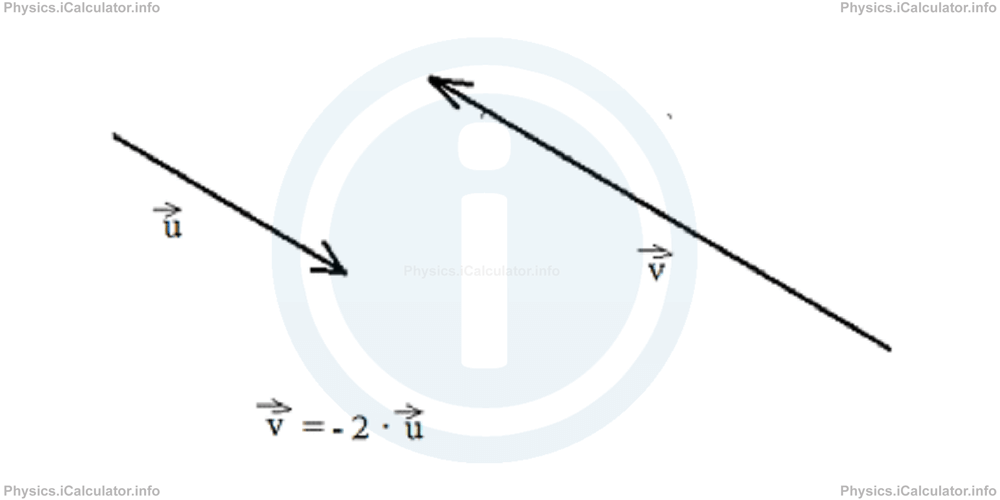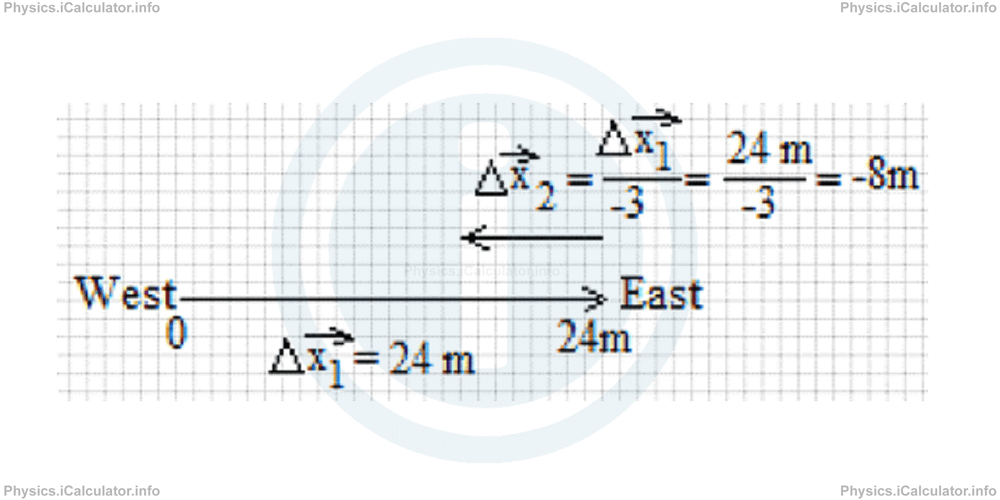Menu
Physics Lesson 2.3.3 - Multiplying a vector by a negative scalar
Please provide a rating, it takes seconds and helps us to keep this resource free for all to use
Welcome to our Physics lesson on Multiplying a vector by a negative scalar, this is the third lesson of our suite of physics lessons covering the topic of Multiplication of a Vector by a Scalar, you can find links to the other lessons within this tutorial and access additional physics learning resources below this lesson.
Multiplying a vector by a negative scalar
It is obvious that when we multiply a (positive) vector by a negative scalar, this results in a negative vector. This is because (+) × (-) = (-). Therefore, when multiplying the vector u⃗ by a negative number N, the result will be still v⃗ = N × u⃗ but the direction of v⃗ will be the opposite of u⃗. For example, if N = -2, the vector v⃗ is twice as long as the vector u⃗ but these vectors have opposite direction. Look at the figure below:

From the figure, it is easy to notice that when a vector is obtained by multiplying another vector by a negative scalar, the two vectors in question are antiparallel (i.e. parallel but with opposite direction).
The same is true for the division of a vector by a scalar as well. The two vectors will have again opposite direction. The only difference is that the second (output) vector will be smaller in length than the first (input) one.
Example 3
An object moves linearly by 24 m due West. Then it moves in the opposite direction by one third the magnitude of the first displacement.
What is the second displacement of the object in metres?
Show the two vectors in a figure by making a suitable sketch.
What is the final position of the object if we take as zero the initial position (starting point)?
Solution 3
a. This is a typical example of the division of a vector by a negative scalar where the final vector will have an opposite direction to the original one. Since the first displacement ∆x⃗1 is due West, the second displacement ∆x⃗2 will be due East. We can write:
Or
Thus, the second displacement is 8m due East.
b. The situation is graphically represented through the figure below.

c. From the figure, it is obvious the object's final position (which represents the total displacement Δx⃗tot is calculated by adding the two displacements (see the topic "Addition and Subtraction of Vectors"). Thus, we have
= 24m + (-8m)
= 16m
Therefore, at the end of motion the object will be at 16 m due East to the original position.
You have reach the end of Physics lesson 2.3.3 Multiplying a vector by a negative scalar. There are 4 lessons in this physics tutorial covering Multiplication of a Vector by a Scalar, you can access all the lessons from this tutorial below.
More Multiplication of a Vector by a Scalar Lessons and Learning Resources
Whats next?
Enjoy the "Multiplying a vector by a negative scalar" physics lesson? People who liked the "Multiplication of a Vector by a Scalar lesson found the following resources useful:
- Negative Feedback. Helps other - Leave a rating for this negative (see below)
- Vectors and Scalars Physics tutorial: Multiplication of a Vector by a Scalar. Read the Multiplication of a Vector by a Scalar physics tutorial and build your physics knowledge of Vectors and Scalars
- Vectors and Scalars Video tutorial: Multiplication of a Vector by a Scalar. Watch or listen to the Multiplication of a Vector by a Scalar video tutorial, a useful way to help you revise when travelling to and from school/college
- Vectors and Scalars Revision Notes: Multiplication of a Vector by a Scalar. Print the notes so you can revise the key points covered in the physics tutorial for Multiplication of a Vector by a Scalar
- Vectors and Scalars Practice Questions: Multiplication of a Vector by a Scalar. Test and improve your knowledge of Multiplication of a Vector by a Scalar with example questins and answers
- Check your calculations for Vectors and Scalars questions with our excellent Vectors and Scalars calculators which contain full equations and calculations clearly displayed line by line. See the Vectors and Scalars Calculators by iCalculator™ below.
- Continuing learning vectors and scalars - read our next physics tutorial: Dot (Scalar) Product of Two Vectors
Help others Learning Physics just like you
Please provide a rating, it takes seconds and helps us to keep this resource free for all to use
We hope you found this Physics lesson "Multiplication of a Vector by a Scalar" useful. If you did it would be great if you could spare the time to rate this physics lesson (simply click on the number of stars that match your assessment of this physics learning aide) and/or share on social media, this helps us identify popular tutorials and calculators and expand our free learning resources to support our users around the world have free access to expand their knowledge of physics and other disciplines.